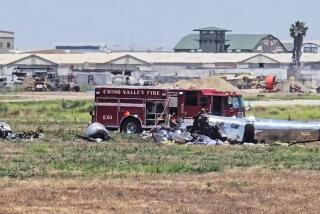Jetliner Crashes in S. Korea
SEOUL — An Air China passenger plane on its way to the South Korean city of Pusan crashed into a mountainside this morning while approaching an airport heavily shrouded in fog.
There were 155 passengers and 11 crew members aboard. Fourty-seven people were removed from the wreckage and taken to Pusan-area hospitals, Yoon Sun Jung of the Home Affairs Ministry told the Reuters news agency. He said 44 of the 47 were alive.
Sixteen of the passengers worked for the same South Korean fire insurance firm and were returning from a company-paid vacation.
The Boeing 767 from Beijing went down at about 11:45 a.m. Earlier in the morning, poor visibility around Pusan and other cities in the southern part of the Korean peninsula had forced cancellation of nearly 40 flights.
The pilot of the Air China plane apparently was trying to turn back and crashed into the mountainside while attempting a U-turn.
“Just before the crash, the pilot broadcast, ‘We will land at Kimhae Airport in a few minutes.’ Then the plane started shaking and filled with smoke,” a survivor identified as Kim Moon Hak told South Korean television.
Poor weather was suspected as the cause of the crash, although some witnesses reported that the plane started to burn before it hit the ground, which would imply either engine malfunction or sabotage.
“There was a flame from the tail part of the plane before it crashed,” said a witness who was quoted on South Korea’s KBS News.
“I was a little dizzy. I was leaning down to the floor of the plane. There was a big shock. I don’t know what happened next,” said another survivor, Kang Man Se, a woman in her 50s, who was quoted from her hospital bed by South Korean cable news channel YTN.
The mountain that Flight CA-129 crashed into is just outside the Pusan airport, and the plane narrowly missing an apartment complex. South Korean television showed footage of the aircraft broken in half and in flames.
Kim, the survivor, managed to stagger away from the wreckage to a police call box and report the crash. He said there were other survivors.
Pusan is South Korea’s second-largest city, 200 miles southeast of Seoul.
The passengers were mostly South Koreans on their way home from vacation in China. Witnesses said rescue workers were having difficulty reaching possible survivors because of the burning wreckage.
“It’s on top of a mountain. There is a black cloud of smoke, which makes it dangerous for rescuers to approach the aircraft,” a television journalist reported from the scene. Television news showed dramatic footage of rescuers making their way through a forest burning from the wreckage.
The South Korean Ministry of Construction and Transportation set up an emergency committee to investigate the accident.
Air China is China’s flag bearer and its largest airline in terms of traffic volume, according to the airline’s Web site. Air China has not had a fatal crash since it was founded in 1988, according to the aviation safety Web site Airsafe.Com.
More to Read
Sign up for Essential California
The most important California stories and recommendations in your inbox every morning.
You may occasionally receive promotional content from the Los Angeles Times.










